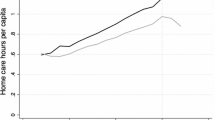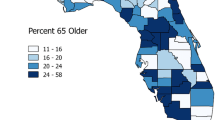Abstract
Background
An analysis of a provincial home care dataset, comparing home care client, service, and providers in 1991/92 through 2000/01, was undertaken to describe changes over the decade, and permit a more informed discussion of home care in relation to Canadian health policy developments and health system reforms.
Methods
After data were obtained upon request from Alberta’s Ministry of Health and Wellness, descriptive and comparative statistical analyses were undertaken using the SPSS computer program. Logistic regression was used to compare multiple client characteristics in the first and last years.
Results
Home care clients doubled and the mean hours of care per client increased substantially, although the duration of care provision declined. The mean age of clients also declined. Home care continued to be primarily provided by Home Support Aides, with self-managed care increasing dramatically. Sustained geographical differences in home care were noted.
Conclusion
Although home care has much potential for enabling early discharge from hospital, and for maintaining or improving health, few population-level studies of home care trends exist. In Alberta, although formal home care hours increased, home care expansion was not uniform across the province. Home Support Aides continued to be the primary care provider. In the face of substantial hospital downsizing, these observations could imply that the provision of home care has been off loaded to families. Moreover, home care increases do not appear to be related to an aging population.
Résumé
Contexte
On a entrepris une analyse comparative des données liées aux clients, aux services et aux fournisseurs du secteur des soins à domicile, de 1991–1992 à 2000–2001. L’analyse avait pour but de décrire les changements survenus au cours de cette décennie et de permettre une discussion plus éclairée auprès des intervenants du secteur des soins à domicile, à la lumière des développements de la politique canadienne de la santé et des réformes du système de santé.
Méthodes
Après avoir obtenu du ministère de la santé et du mieux-être (Ministry of Health and Wellness) de l’Alberta les données demandées, on a entrepris des analyses descriptives et comparatives à l’aide du logiciel SPSS. La régression logistique a permis de comparer les caractéristiques de la clientèle au cours de la première année et des dernières années.
Résultats
La clientèle des soins à domicile a doublé et la moyenne d’heures de soins prodigués à chacun des patients a augmenté de façon importante et ce, même si on constate une diminution de la durée de prestation des soins. De plus, on observe une diminution de l’âge moyen des clients. Les soins à domicile continuent d’être prodigués, de façon prédominante, par les aides du soutien à domicile; on observe une augmentation nette de la prise en charge des soins par les clients. On relève des écarts persistants dans la prestation des soins à domicile entre les différentes zones géographiques.
Conclusion
Même si les soins à domicile offrent une possibilité réelle que le patient reçoive un congé précoce de l’hôpital et qu’il maintienne, voire améliore, son état de santé, il existe peu d’études de la population consacrées aux tendances dans le secteur des soins à domicile. En Alberta, même si on note officiellement une augmentation de la prestation de soins à domicile, on observe un manque d’uniformité au chapitre de l’expansion des soins à domicile à l’échelle provinciale. Les aides au soutien à domicile continuent de représenter les principaux fournisseurs de soins. Dans le contexte de la restructuration importante des établissements hospitaliers, une telle situation pourrait inciter à conclure que l’on a transféré aux familles la responsabilité de prodiguer les soins à domicile. De plus, l’augmentation des soins à domicile ne semble pas être liée au vieillissement de la population.
Similar content being viewed by others
References
Health Canada. Provincial and territorial home care program: A synthesis for Canada. Ottawa, ON: Minister of Public Works and Government Services, June 1999.
Sheps SB, Reid RJ, Barer MJ, Kreuger H, McGrail KM, Green B, et al. Hospital downsizing and trends in health care use among elderly people in British Columbia. CMAJ 2000;163(4):397–401.
International Conference on Primary Health Care. Declaration of Alma-Ata. WHO Chronicle 1978;32(11):428–30.
Pappas G, Moss N. Health for all in the Twentyfirst century, World Health Organization renewal, and equity in health: A commentary. Int J Health Serv 2001;31(3):647–58.
Wilkins K, Park E. Home care in Canada. Health Rep 1998;10(1):29–37.
Alibhai A, Saunders D, Johnston SW, Bay K. Total hip and knee replacements in Alberta utilization and associated outcomes. Healthcare Manag Forum 2001;14(2):25–32.
Osborne D, Gaebler T. Reinventing Government. How the Entrepreneurial Spirit is Transforming the Public Sector. New York, NY: Penguin Books, 1993.
Alberta Health and Wellness. Three year business plan, 1995/96–1997/98. Edmonton, AB: Author, 1995.
Chen J, Wilkins R. Seniors’ needs for healthrelated personal assistance. Health Rep 1998;10(1):39–50.
Commission on the Future of Health Care in Canada. Building on values. The future of health care in Canada. Final Report. Ottawa, ON: Minister of Public Works and Government Services, 2002.
Fainsinger RL, Bruera E, MacMillan K. Innovative palliative care in Edmonton. Can Fam Phys 1997;43:1983–86, 1989–92.
McWhinney IR, Bass MJ, Orr V. Factors associated with location of death (home or hospital) of patients referred to a palliative care team. CMAJ 1995;161(4):361–67.
Coyte PC, Young K. Regional variations in the use of home care services in Ontario, 1993/95. CMAJ 1999;161(4):376–80.
Cranswick K. Who needs short-term help? Can Social Trends 1999; Summer:11–15.
Chochinov HM, Kristjanson L. Dying to pay: The cost of end-of-life care. J Palliat Care 1998;14(4):5–15.
Aronson M, Dento M, Zeytinoglu I. Market modelled home care in Ontario: Deteriorating working conditions and dwindling community capacity. Can Public Policy 2004; 30(1):111–25.
Alcock D, Danbrook C, Walker D, Hunter C. Home care clients, Providers and costs. Can J Public Health 1998;89(5):297–300.
Author information
Authors and Affiliations
Corresponding author
Additional information
Disclaimers: This article is based on a report completed for a study “Integrated End-of-life Care: A Health Canada Synthesis Research Project” funded by Health Canada (#6795-15-2002/4780004). The interpretations and conclusions contained herein are those of the researchers and do not necessarily represent the views of the Government of Canada nor of Health Canada. Neither the Government of Canada nor Health Canada express an opinion in relation to this study.
Acknowledgements/Source of funding: The research funding provided by Health Canada for this project is gratefully acknowledged. The researchers would also like to acknowledge Alberta Health and Wellness personnel for their data assistance. Co-investigators were extremely helpful to this study: Dr. Stephen Birch, Margaret Brown, Drs. Lise Fillion, Christopher Justice, and Janice Kinch, Karen Leibovici, Drs. Tom Noseworthy and Karen Olson, Pam Reid, David Shepherd, and Dr. Margaret MacAdam. The statistical consultation and data analysis assistance provided by Dr. Colleen Norris was outstanding.
This portion of the Health Canada End-of-life Synthesis Research study was based on data provided by Alberta Health and Wellness. The interpretation and conclusions contained herein are those of the researchers and do not necessarily represent the views of the Government of Alberta nor of Alberta Health and Wellness. Neither the Government of Alberta nor Alberta Health and Wellness express any opinion in relation to this study.
Rights and permissions
About this article
Cite this article
Wilson, D., Truman, C.D., Huang, J. et al. The Possibilities and the Realities of Home Care. Can J Public Health 96, 385–389 (2005). https://doi.org/10.1007/BF03404038
Received:
Accepted:
Published:
Issue Date:
DOI: https://doi.org/10.1007/BF03404038




